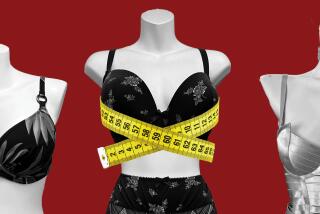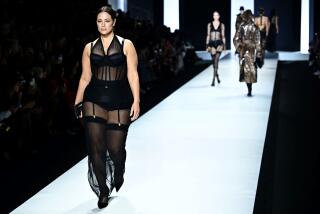For Good Measure : Women Undergoing Breast Augmentation Are Telling Doctors Bigger Is Better
- Share via
SHORT, CLINGY fashions have put the body in focus this spring, and the ultimate test, bikini season, is just around the corner. Many women are starting to diet and exercise strenuously in a last-ditch effort to get their figures in shape. Others are taking more drastic action and heading for the plastic surgeon.
But trimming thighs and fannies via the fat-suctioning technique known as liposuction is no longer the latest news in body sculpting. This year, the buzz among Southern California plastic surgeons and their patients is big breasts --very big breasts.
Armed with photos of bare-chested female models from men’s magazines, prospective patients are consulting surgeons and making explicit demands. They want to see dramatic changes--more cleavage, increased fullness, higher breasts, more projection. They want to fill a size 38-C bra.
In the past, most women who have decided on breast augmentation have tended to be conservative--”perhaps requesting an increase from an A cup to a B cup, or from a B to a B-plus cup. Now women want C’s and D’s,” says La Jolla plastic surgeon Gary Manchester. “In 19 years in practice, I’ve never seen a demand for such large breasts as we’re experiencing now.”
The trend toward bigger bosoms began in the mid-1980s, when shapely models such as Paulina Porizkova and Elle Macpherson graced the pages of women’s fashion magazines and Sports Illustrated’s famed swimsuit issue. Not surprisingly, after years of stick-thin cover girls, their fuller figures provided a refreshing, ultra-feminine look.
But women who are in the market for more curves typically don’t bring their doctors pictures from Vogue and Harper’s Bazaar. They go with Penthouse and Playboy in hand. “It doesn’t do any good to bring in pictures from fashion magazines,” one recent patient says. “Those women are dressed.”
Regardless of where the photos come from, a woman’s bustline can’t always be augmented to duplicate the desired look. “The breast is like a tent,” explains Manchester, who performs about 130 enlargement procedures each year. “You have to stay within the confines of those ligaments that determine the shape of the augmented breast.”
Fluid-filled silicone implants increase the size of the natural breast. Five years ago, the 150- to 200-cubic-centimeter implants were the most popular sizes. Now more women are asking for the 275- to 300-cubic-centimeter implants, according to Dr. Neal Handel, chief of plastic surgery at The Breast Center in Van Nuys, which specializes in breast problems as well as reconstructive and cosmetic surgery.
Innovations in the design of these implants have helped minimize one of the major problems of breast augmentation: hardening of breast tissue. Instead of the smooth implants that have been used since the early 1960s, many doctors are opting for textured versions or for implants covered with polyurethane foam. Dr. Lawrence Koplin, a Beverly Hills plastic surgeon who performs two to three augmentation surgeries each week, says that he uses the foam-covered versions almost exclusively because of the “natural-feeling” results. “The old, smooth implants had a 25% risk of causing hardening; the new ones have brought that factor down to 2%,” Koplin says.
For some of his patients who request significant enlargement, Koplin also uses a new technique called “stacking,” which is the insertion of two implants in the same breast. “Some women want more cleavage and more projection, which can be achieved by using more than one implant,” he explains.
Of course, before a woman undergoes an augmentation procedure, she should be aware of the risks. Because silicone implants can partly obscure the X-ray view during a mammogram, they may cause a delay of the detection of breast cancer, the most common form of cancer among American women. So patients who have a family history of breast cancer or who have had pre-cancerous abnormalities are usually advised not to undergo the procedure.
Still, there are women who are determined to have larger breasts. More than 70,000 women in the United States underwent augmentation surgery in 1988, according to a survey by the American Society of Plastic and Reconstructive Surgeons. If the trend toward more voluptuous chests continues, tens of thousands more women women may, indeed, be thinking big.
Stylist: Julie Vogel/ Cloutier






